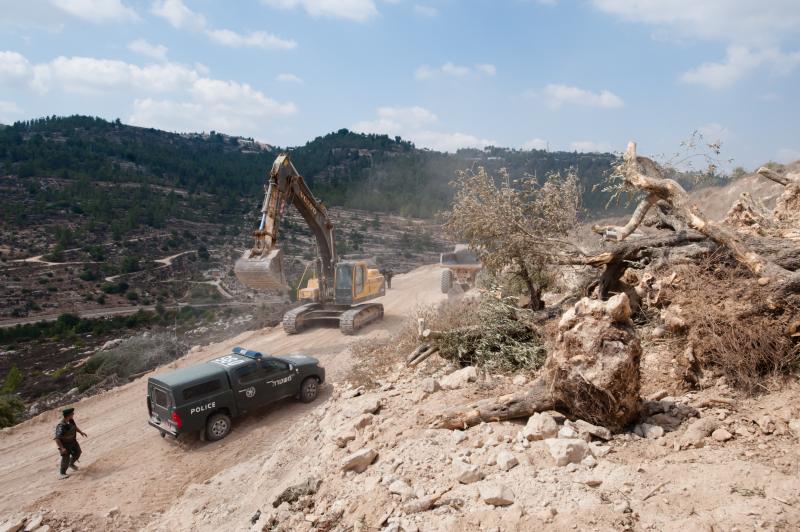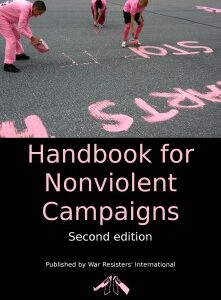In Defense of Land and Heritage


Since I was a young girl my summers have been spent in the presence of my grandmother and her olive grove in our small village near the West Bank city of Nablus. My grandmother would take me and my brothers to the olive grove and show us the olive trees that she planted with her family during her youth. She would tell us, “I consider these olive trees to be like my chil- dren.” As somebody who grew up in America, for a long time I only thought of trees as a source of food. But over time I came to understand that for Palestinians the olive tree is a symbol of resistance, steadfastness, and our cultural heritage.
Over the years, riding through the valleys and over the hills of the West Bank, past cities and villages, I would notice olive trees that were either uprooted, cut down, or burnt to the ground. This was all part of Israel’s systematic policy of destroying Palestinian olive groves, often disguised by the rhetoric of “security concerns.” The impact of this policy is further compounded by the apartheid wall, which in some places separates Palestinian farmers’ homes from their farmland.
A recent example of these policies occurred when Israel ordered Palestinian farmers in the West Bank village of Deir Istiya to uproot 1400 of their olive trees by May 1st of this year. Deir Istiya is one of the largest olive-producing villages in the West Bank, and the destruction of these olive groves jeopardized the livelihoods of several villagers. There were frequent reports of these occurrences during the beginning of the construction of the apartheid wall Israel built and is continuing to build all over occupied Palestinian land. Hundreds of thousands of olive trees have been uprooted throughout the West Bank and it has been a major focus of popular resistance.
Many of the popular resistance weekly demonstrations that happen through out the West Bank were in fact originally moti- vated by the ongoing and rapid uprooting of olive trees. Villages from the Nablus district to South Hebron Hills rallied against the razing of their farmlands. In the early 2000’s, popular nonviolent demonstrations came into action when the razing by the Israeli military became more routine.
Budrus, a Palestinian village about 12 kilometers northwest of Ramallah and no more than 3 kilometers from the green line, demonstrated against the construction of the apartheid wall that was cutting through their land and uprooting the village’s olive trees. An agricultural village, Budrus is home to many generations of farmers. In 2003, Israel began to implement a plan to confiscate nearly 1200 dunams of Budrus’s land in order to construct its separation barrier. This wall would have bound and isolated Budrus from other nearby villages. In response, the people of Budrus started to demonstrate regularly, marching peacefully alongside international and Israeli activists. Some of the demonstrators in Budrus faced down Israeli bulldozers that came to destroy their olive groves and steal their land. Over a 10 month period, the residents held 55 demonstrations, until in 2004 they were successful in forcing the Israeli military reroute the path for the separation barrier. Inspired by the success in Budrus, other villages throughout the West Bank such as Al Khadr, Biddu, and Beit Jala followed suit. Popular resistance in the West Bank is now becoming tremendously popular among internationals who oppose the illegal Israeli occupation. The originators of these weekly demonstrations were Palestinians who were tired of having their land confiscated and their olive trees uprooted. They welcomed internationals and Israeli activists in the nonviolent effort to oppose the violent actions perpetuated by the Israeli military, but something happened and the original message of resistance became lost.
The demonstrations were co-opted by mainstream and outsider groups who did not understand their value to the inhabitants of the land they were supporting. For example, when members of the Palestinian Authority participated in these marches, they put themselves in front of the cameras the whole time. The Palestinian Authority does not represent the true will of many of these villagers. They seem to have no clue as to what the protests are about and have forgotten that the origin of this resistance was from the Palestinian farmers who see their land and their olive trees as a part of themselves, farmers who would literally sit next to an olive tree, under a bulldozer, to protect the tree from harm.
The number of individuals participating in demonstrations scattered throughout the West Bank has increased tremendously throughout the years. However, this has not necessarily benefitted the popular resistance movements. With more people partaking in these protests, the message seems to be disappearing. The voices of the locals are being obscured by foreign activists and the Palestinian Authority looking for the next photo opportunity or for a slot during a primetime Al Jazeera news special. The demonstrations have lost touch with their original purpose and are no longer innovative. As a movement, we need to look back at the history of popular resistance and build on what has already been done.
Demonstrations have not been the only form of resistance to the uprooting of olive trees. There are other initiatives that take a different approach. For example, internationals have come to help havest the olive trees. Organizations also replant trees in areas that have been frequently targeted by the uprooting, cutting down, or burning of olive trees.
The Palestine Solidarity Project (PSP), which is based in the village of Beit Ommar, is one organization that has been very active both in campaigns that replant olive trees and in weekly demonstrations. “Save the land” is the name of the campaign that PSP currently runs for the village of Beit Ommar, an agricultural village under constant attack from neighboring settlers and the Israeli military. There are other examples of campaigns like PSP’s in other parts of the West Bank, but the fact of the matter is that the number of olive trees being uprooted, cut down, and burned is significantly larger than the number of trees being replanted. These campaigns are a good way to build awareness and take some sort of action, but more critical thinking is needed about how we can innovate and produce more effective results in the struggle against this violence to our land and our olive trees.
Agriculture has always been vital to economic growth for Palestinians, and it has been a source of health and wellness to us as a people. Palestinians have always identified strongly with their land.
The immortal olive tree will always be a symbol of the Palestinian struggle and Palestinian heritage. Walking through the olive groves and sitting under the trees for inspiration to write and think will always be an important part of my childhood memories.
We are one with the roots that grow our produce and provide us life. Olive trees are a symbol of our past, present, and future. As our olive groves are erased, we are edging dangerously close to losing a vital piece of Palestinian culture, identity, and history.

 Handbook for Nonviolent Campaigns, 2nd Edition
Handbook for Nonviolent Campaigns, 2nd Edition